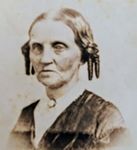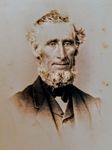EASTFORD HISTORICAL SOCIETY QUARTERLY - Vol.45, No.2 March,2021
←
→
Page content transcription
If your browser does not render page correctly, please read the page content below
EASTFORD HISTORICAL SOCIETY
QUARTERLY
Vol. 45, No. 2 March, 2021
J. D. Barrows – 19th Century Eastford Leader, Part 1
Researched by Tom Hughes
Hughes Family residence, 2021. Home of Joseph D. Barrows and his family in the 1800s. (photo by Tom Hughes)
My family and I moved to Eastford in 2004 looking for an leader in 19th Century Eastford. He was a descendent of a
old house to renovate. Eastford was not unknown to me Mayflower era family. His 4x great grandfather on his
because I had been a Boy Scout camper at Camp Kee- mother’s side, Thomas Dimmick, landed in the Massachu-
mosahbee, (now Crystal Pond Park) in the 1960s. The setts Bay Colony in 1635, only 15 years after the Pilgrims
Greek Revival house we found and purchased on Old Col- landed in Plymouth (Find A Grave).
ony Road needed lots of work, but it has been a pleasure Early Years
updating and restoring the old house. Barrows was born in 1817 in nearby Mansfield, where the
If you live in an old house, you always wonder who lived Barrows family had lived for generations since the 1600s
there before you. Were they good people? How did they (Find A Grave). His father, Salmon Barrows, was a farmer
make a living? What was their life like? Did they leave the and a deacon of the Mansfield Congregational Church
house with good “karma?” (Newspapers.com, Hartford Courant, May 30, 1890). J. D.
During the pandemic I became interested enough in these Barrows was married in Coventry, Connecticut on May 11,
questions to explore them concerning my 200-year-old 1840 at age 23 to Mary Brown, another descendent of ear-
Eastford house. What I found was more interesting than I ly American settlers, according to a newspaper article
ever could have imagined. (Newspapers.com, Hartford Courant, May 13, 1840). Bar-
rows was a deacon of the Eastford Congregational Church
U. S. Census records and town maps from the mid-1800s from about 1844-1873, so he probably settled in Eastford
show that my house was inhabited for over 40 years by around the time he was married, the early 1840s (p. 1036,
John Dimmick (J.D.) Barrows and family. Barrows was a History of Windham County, Connecticut: 1760-1880). It
prominent and very active business, religious and political appears that he came to Eastford to work as a leather tan-West Liberty Tanneries photo, illustrates the process of tanning. (West Liberty Archives)
ner, perhaps as an apprentice. A newspaper article noting cause a periodical published out of Boston in 1876 chose
Barrows’ 50th wedding anniversary, states that he went to to solicit information from him for a news story about
Eastford as a young man and built up an extensive tannery leather tanning. In an article published on July 22nd, enti-
business (Newspapers.com, Hartford Courant, May 31, tled “Concerning Hides and Skins,” Barrows stated that he
1890). He is identified as a tanner in Eastford in multiple was available to perform customized tanning to provide
records including the 1850, 1860, 1870 and 1880 United leather for winter boots with a natural hair lining
States censuses. (Newspapers.com, New England Farmer quoted in the
Leather Tanner Hartford Courant, July 22, 1876). He advised any custom-
er looking for him to tan such hides to salt the hides imme-
In the middle of the 19th century many communities had a diately with coarse salt, using not less than three quarts per
local tanner. The tanner provided leather for shoes, sad- skin, spreading the salt evenly, and then rolling the hides
dles, harnesses, belts, and many other important and essen- tightly before delivering them to him for tanning. Barrows
tial everyday items. Leather was a valued commodity. At noted that he previously specialized in tanning hair stock
that time, leather was also the basis for much of Eastford’s but that he had not done any of that in six or eight years
early industrial economy. The 1850 census reveals that 77 because of the premium price he needed to charge for such
households in Eastford engaged in either shoe or boot- work. He stated that most people wanted to buy boots and
making. One of the biggest mills in Eastford at that time shoes that cost the least money!
was a shoe factory. The factory was in the center of town
near the Still River on the site of the former Coriander res- Barrows stated that his best boot and shoe leather was pro-
taurant. The Barrows tannery no doubt supplied all or duced from hides with the shortest hair, the plumpest
much of the leather for the local shoe and boot industry. shoulders, and the closest flanks. He favored oak bark to
tan these quality hides. He reported that the best hides for
Hides were “tanned” (softened and preserved) in those upper shoe leather came from Devon cows while Durhams
days by successive soaks in a solution of finely ground tree were best for harnesses and heavy leather goods.
bark which contained tannin (The Tannery, An Indispensa-
ble Industry, www.waterfordhistory.org). Hemlock and In some writings about long ago times complied by Mary
oak tree bark were preferred. Grinding the bark was an Green for Eastford’s 1947 centennial celebration she re-
important part of the tanning business. It is noted in a membered a funny story from her childhood about the tan-
newspaper article that Barrows owned a steam engine nery (Eastford 1847-1947 Centennial Book). A fellow
(Newspapers.com, The Boston Globe, March 5, 1873). who worked at the tannery by the name of Charlie Dean
This engine was no doubt used to turn grinding wheels to once found a stray horse wandering around town. Rather
crush the bark into a fine powder. This would have been than find the owner, Dean attached a sign to the horse that
state of the art for the later 19th century, and a good exam- read: “I want to go to Barrows Tan Yard.” This type of
ple of the progression from waterpower to motorized pow- prank was apparently quite typical of Dean. Miss Green
er for industrial purposes. noted that everyone used to have a lot of fun in the old
days too!
Barrows must have been a respected regional tanner be-Banker
In addition to being a tanner, Barrows was also a banker.
He was a founder of Eastford’s first bank: the Eastford
Bank of Savings and Deposits. The bank was started in
1871 by Barrows and the owner of the village shoe factory,
Hiram Burnham (Newspapers.com, Hartford Courant, May
25, 1871). In 1883 Barrows is identified as the president of
the bank and Burnham as the treasurer (p. 1527, New Eng-
land Business Directory and Gazetteer, 1883). It was locat-
ed on the first floor of the shoe factory. It was in business
until 1884, when it went into receivership
(Newspapers.com, The Morning Courier, January 5, 1884).
Barrows and Burnham were undoubtedly close business
associates, one being a tanner and the other a shoemaker.
Many banks were being chartered in Connecticut at this
time and the two men must have thought that Eastford’s
then bustling economy would benefit from its own bank so
local savings could finance local businesses. In the middle
of 19th century, Eastford was a much busier place than it is
today. According to a narrative written by John Trowbridge
about growing up in Eastford during this time, he recalls
Eastford Bank of Savings and Deposits, that Eastford had at least six factories, three or four grist
1876 Mortgage interest payment. (EHS Archives) mills, as many sawmills, seven or more stores of general
merchandise, a drugstore, and a lady’s millinery establish-
ment (Trowbridge, p. 392, History of Windham County,
Connecticut: 1760-1880).
Town Government Official
Barrows also served in town government in a variety of
capacities over many years. He was the town probate judge
from 1863-1869. From 1869 to 1874 he was the town
treasurer and from 1873 to 1880 he was the town clerk
(Hartford Courant, October 8, 1880). He was also what
was called at the time a school visitor, a position somewhat
equivalent to a school board member today (Keyes, Wind-
ham County Observer, March 19, 1913). As a school visi-
tor he traveled to Eastford’s several schools and wrote re-
ports about how the schools were functioning and improve-
ments that needed to be made. Barrows served in important
town government positions for about 20 years in addition to
running an important business and serving as a church dea-
con.
Deacon of the Congregational Church, Temperance
Leader and Neighbor
In a narrative written by Warren Keith at age 91 in 1947
about his youth in Eastford he recalls a humorous story
about Deacon Barrows (Keith, Putnam Patriot, 1947). It
was the custom in the old days that when anyone died in
town Deacon Barrows would walk up the hill from his
house to the Congregational Church to ring the church bell.
The bell was tolled in strokes of ten to recount a deceased’s
age. Then after a pause, the bell would be tolled once if the
deceased was a man and twice if a woman. When Deacon
Barrows got along in age and found the walk up to the
church difficult, he hired Warren, as child, to do the tolling.
He paid Warren 25 cents for each job. Warren recalls he
once had to toll the bell for woman over 90 years old. He
felt he really earned his 25 cents that day.
J. D. Barrows, Town Treasurer, Eastford Town Report,
1873-1874. (EHS Archives)In 1871, at a meeting held home. As Susie
in Meriden, Barrows was came down the hill
elected as a vice president with her father,
of the newly formed Con- she remembers
necticut State Temper- praying that Dea-
ance League con Barrows had
(Newspapers.com, Hart- gone inside so he
ford Courant, May 18, wouldn’t see her
1871). At the meeting it with her father.
was stated that the league No such luck. As
should supply a moneyed she passed Bar-
basis upon which to pros- rows, she remem-
ecute the temperance bers him saying,
work in all proper ways. “Told you you
One day Barrows was were running
sitting on his front porch away!” She felt
when a neighboring very humiliated
Deacon Joseph D. Barrows young girl came trudging (Black Tales, Mary Brown Barrows
(EHS Archives) up the hill. It was S. Flor- Francis Latham (EHS Archives)
ence Warren (Latham), Black).
known as Susie. Suspecting something was going on, Bar-
rows asked Susie if she was running away. She said, “Of
course not, I’m going to see Jesse Bowen.” Soon her fa- To be Continued in the June Issue of the Quarterly
ther came by in a hurry to catch up with Susie to bring her
Painting of Barrows Tannery by Rachel Beebe Oct. 17, 1960 (Judith Bartlett Converse Collection)You can also read
























































